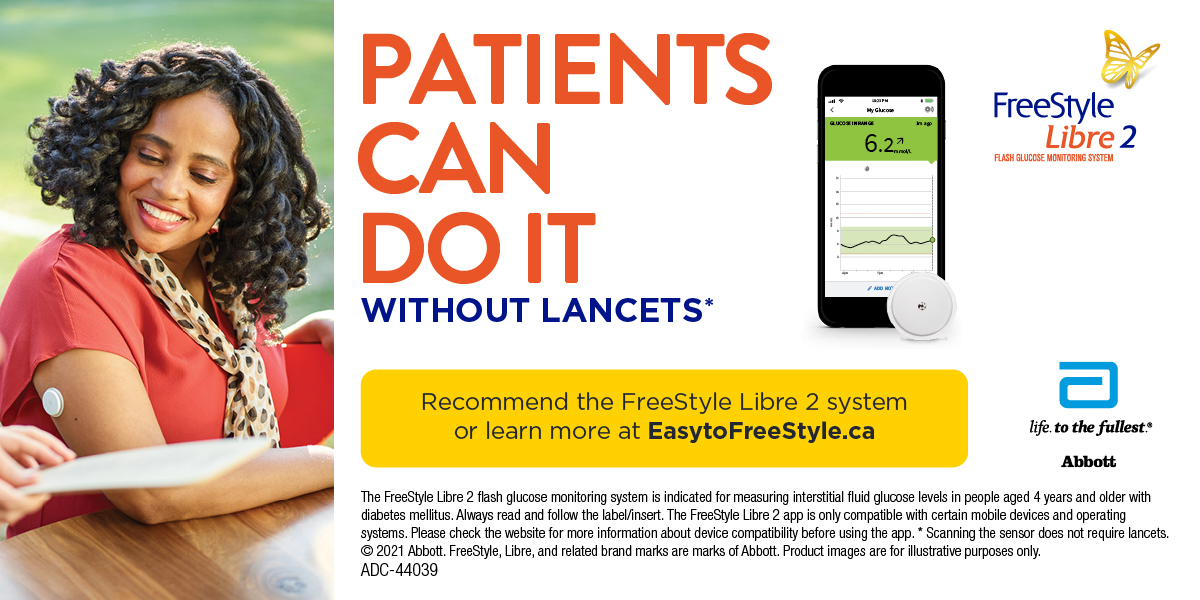How technologies and conversations are informing the discussion concerning substance use
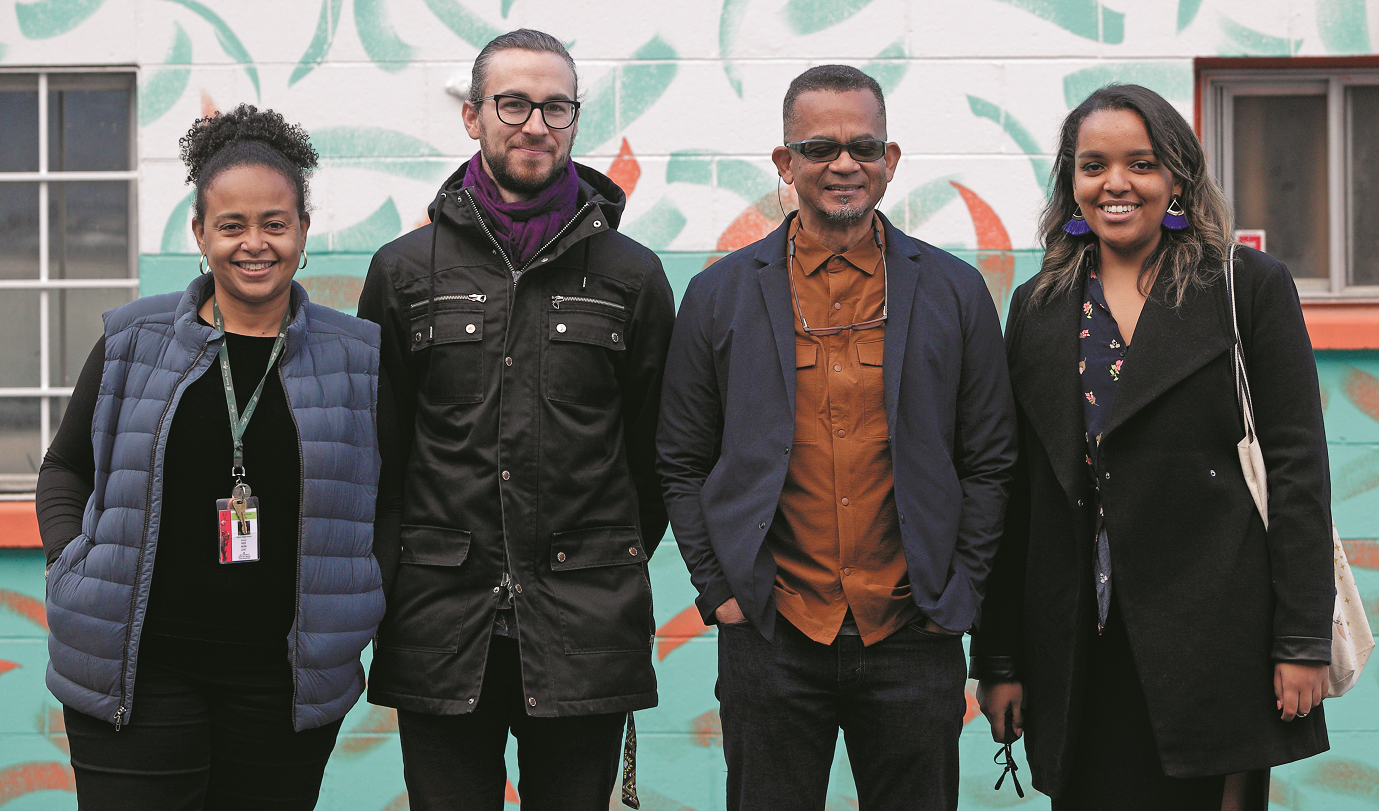
From left: Sandy Angus-Vincent (The Daily Dose Society), Jarred Aasen, Alain Vincent (STS Pharmacy Owner) and Lucy Hagos (Harm Reduction Coordinator).
By Jarred Aasen, RPh. | jaasen@uvic.ca | @JarredAasen
Across Canada and beyond, the toxic drug supply crisis is growing and has claimed the lives of tens of thousands. In British Columbia six people die every day. The illicit supply, especially down, is highly variable in both unexpected additives and concentration of active ingredients. ‘Down’ is an umbrella term for street-derived opioids. Historically, the active ingredient was heroin (diacetylmorphine) but now it is fentanyl.
The fact that illegal substances are involved with a major health crisis creates barriers to care. From a patient perspective, asking for help with illicit substance use is admitting guilt in participating in the black market. It is time governments lift the burden of criminalization from issues concerning substance use, and allow science and health-care services — which include the voices of people who use drugs — to help implement novel solutions. One such application is drug checking.
What is drug checking?
Drug checking is a novel health service where a service user submits a small amount of their drug to be chemically analyzed. The results along with appropriate messaging are disclosed back to the service user. The results are useful on an individual level — i.e. for the service user to find out whether the drug they have is what they believed they purchased. The aggregated results are useful on a societal level to inform the greater discussion surrounding substance use, and allows for early detection of trends within the drug market. Drug checking is one of the harm reduction initiatives to address this crisis — alongside opioid agonist therapy (OAT), safe supply and supervised consumption sites.
Pharmaceutical quality control is not a new concept. Health Canada outlines standards and acceptable amounts of variation for medication produced in Canada. Consumer protections available for regulated substances — which include pharmaceuticals, health products, tobacco, cannabis and alcohol — are not available within the unregulated market.
This means that the illicit supply can be highly variable with potentially unknown and dangerous additives. It is for this reason that the overdose crisis is now being called the toxic drug supply crisis. There are calls nationally for decriminalization, legalization and regulation of illicit psychoactive substances. These important discussions, however, are beyond the scope of this article.
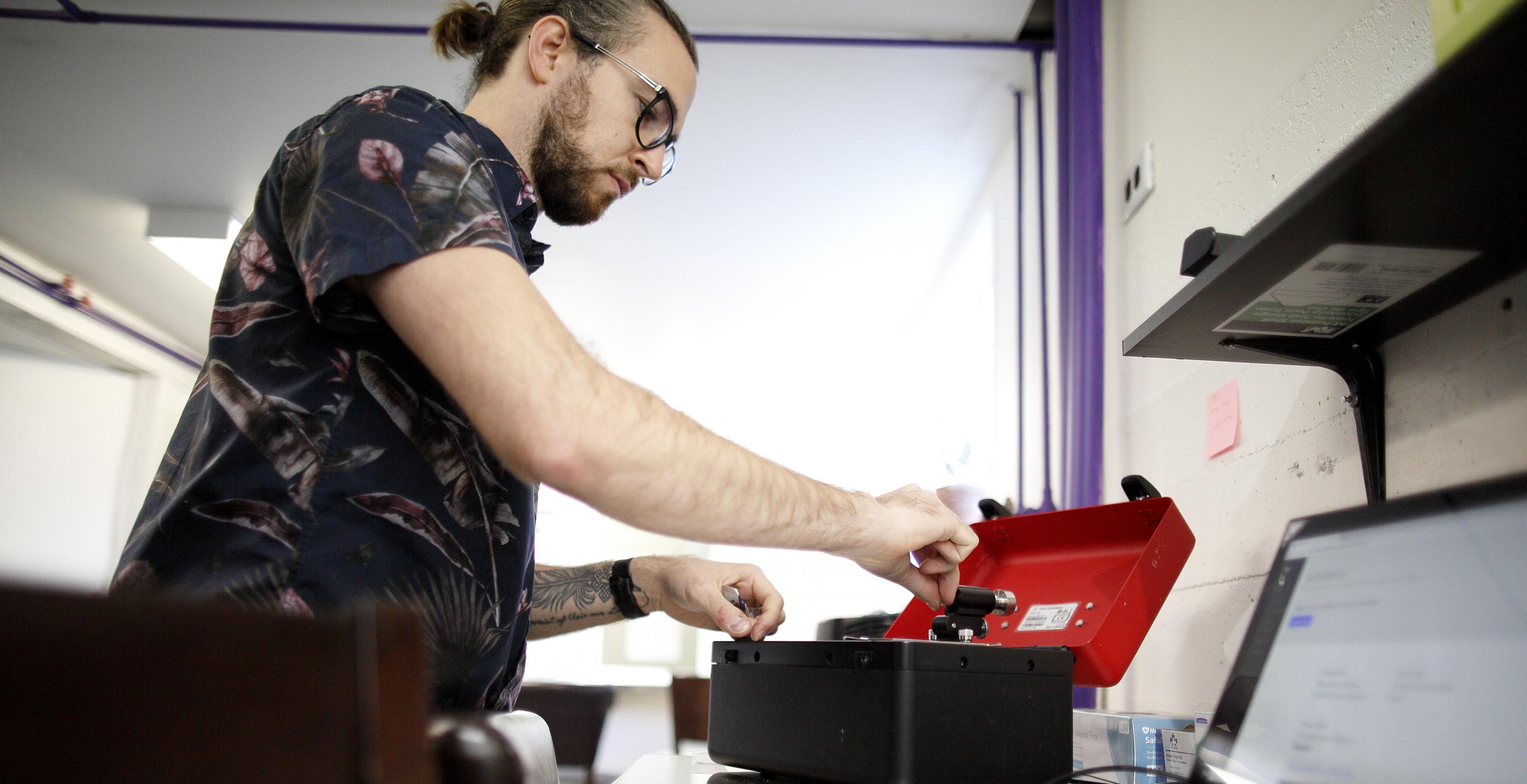
Jarred Aasen operating an Fourier Transformed Infrared (FTIR) spectrometer.
In this article I will share my story as a pharmacist in drug checking, founder of Lantern Services — Canada’s first federally exempted drug checking site as told by Health Canada — and speak to the utility of drug checking and how pharmacists could further adopt this service into their practice.
It was through providing care through an OAT focused harm reduction style pharmacy where we identified an unanswered question: is there fentanyl in my drugs?
Reacting to Emerging Health Issues
The year was 2017, and I was a starry eyed graduate from the University of Saskatchewan class of 2015 living in Victoria, British Columbia. I worked at an independent pharmacy called STS Pharmacy which had a unique harm reduction focus. Our main patient base was people experiencing homelessness and people who use drugs (PWUD). STS Pharmacy recognized that people used drugs, and provided care to lessen the harms associated with their use. If people wanted to stop using the street supply, or wanted to taper off their prescribed replacement therapy — to abstain from using — then we supported them to do so.
At STS Pharmacy there was always a warm pot of coffee brewing, and on the walls hung various artwork that patients had submitted for display. Patients had access to storage lockers for their personal items. For people experiencing homelessness, having a safe place to offload some items was appreciated. The tireless care for this community was made possible by pharmacy owner and manager, Alain Vincent — a man of great virtue and patience — along with his wife Sandy — a woman of unending positivity and compassion.
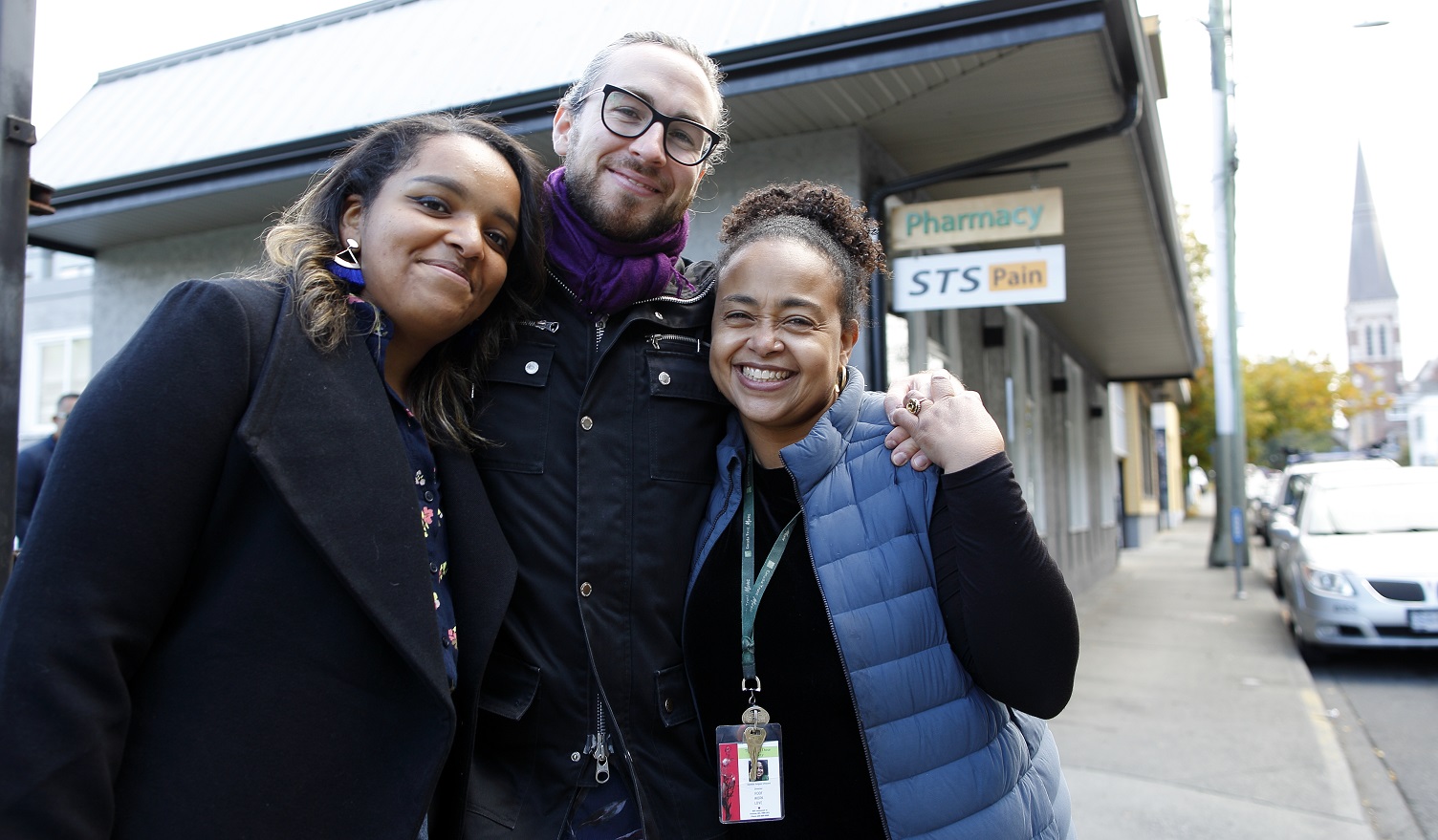
Lucy Hagos, Jarred Aasen and Sandy Angus-Vincent pose for a photograph outside STS Pain Pharmacy.
As a health-care worker and pharmacist, my goal is to improve the health outcomes of those I am serving. To support the primary pharmaceutical focus of the specialized provision of OAT, STS Pharmacy had no over-the-counter area, no raised dispensary and pharmacy staff were easily accessible for questions. Through daily conversations and check-ins, we got to know each and every patient. As they spoke to us regarding their health concerns, one of the issues that consistently came up was the question: what was in their substances?
In 2017, fentanyl was still a mysterious substance to the general public. There were worries that it was present in all illicit drugs, or that simply touching it would be fatal. There was uncertainty and fear within the drug using community, and overdose rates were steadily climbing. It is one thing to read about overdoses in the newspaper and see the figures. The experience is quite different to hear from your patients that their roommate or friend had passed away. Sometimes a patient would not show up for days before word got to us that they had passed away due to drug poisoning. It was grim.
Many patients were interested in taking action to protect themselves. They asked questions about fentanyl, and inquired whether it was in the substances they were using. Alain proposed the idea of using fentanyl strip tests — originally intended for urinalysis — to test street substances. These strips are an immunoassay test strip that are highly sensitive to the presence of fentanyl.
We began testing our patients’ substances with these strip tests, and as we collected more test results, we began to tabulate and post them on social media. This got the interest of the local news outlet2. Following the exposure, we began receiving people coming through the pharmacy doors that were not our typical patients. We began having working professionals, students and concerned parents coming through.
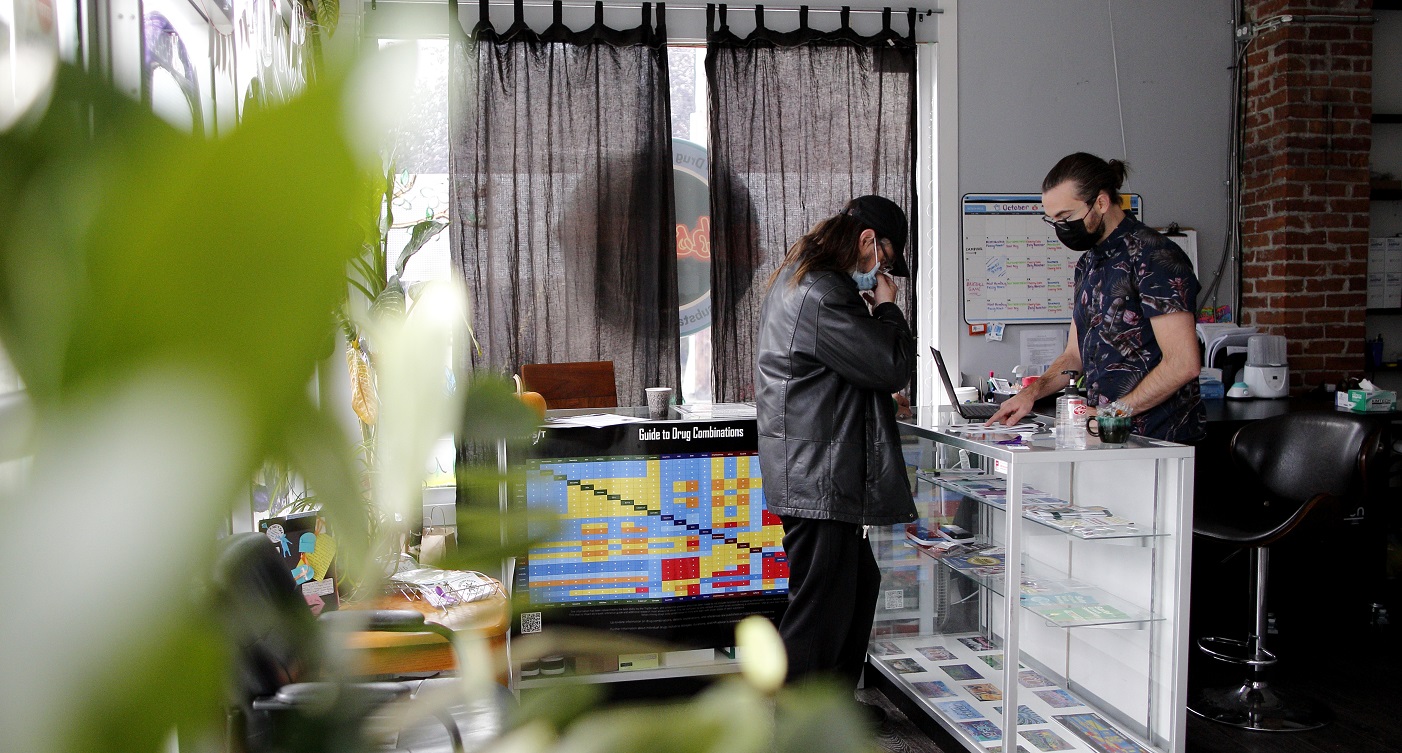
Due to the ongoing toxic drug supply crisis, drug checking has become an in-demand service among all drug users, including working professionals, students and even concerned parents. This photo was taken at the Substance Drug Checking Centre at 1802 Cook Street in Victoria.
It was clear this service was in demand and it felt good to be providing a service that people were actively seeking to protect their well-being. The pharmacy began to provide more naloxone training, drug education and answering of questions than ever before.
In spring of 2017, we were providing naloxone training to a group of teenage girls when midway through they all began to cry. Through tears, they told us they recently lost a friend to an overdose, and that was the reason why they were receiving this training. It was a heavy moment, and a grim reminder of the seriousness of this area. This is only one such story.
In July 2017, three months into providing this service and in the midst of this crisis, the College of Pharmacists of British Columbia sent a letter to stop testing illicit substances in the pharmacy. The College suggested we pursue a Section 56 exemption to the Controlled Drugs and Substances Act. Despite feeling unsupported by the College, Alain, myself and Lucy Hagos — a local harm reductionist — began assembling our exemption application.
I began researching other drug checking programs in Canada and found out this service was mainly undertaken in an event setting. In the summer of 2017, I reached out to Chlöe Sage, the coordinator of ANKORS’ Shambhala Music Festival’s world renowned drug checking program. Lucy and I volunteered on her team that summer, and learned more about drug checking in a festival context. This invaluable experience helped strengthen our application.
We spent much of 2018 communicating with Health Canada for this Section 56 exemption. Lucy and I approached organizations for letters of support, and to our pleasant surprise, we had many letters forwarded to Health Canada, which helped keep our application relevant and urgent.
In early 2019, the newly renovated space located in the basement of STS Pharmacy was inspected by Health Canada and formally approved for Canada’s first Section 56 Exemption for Drug Checking Purposes. And thus Lantern Services was founded.
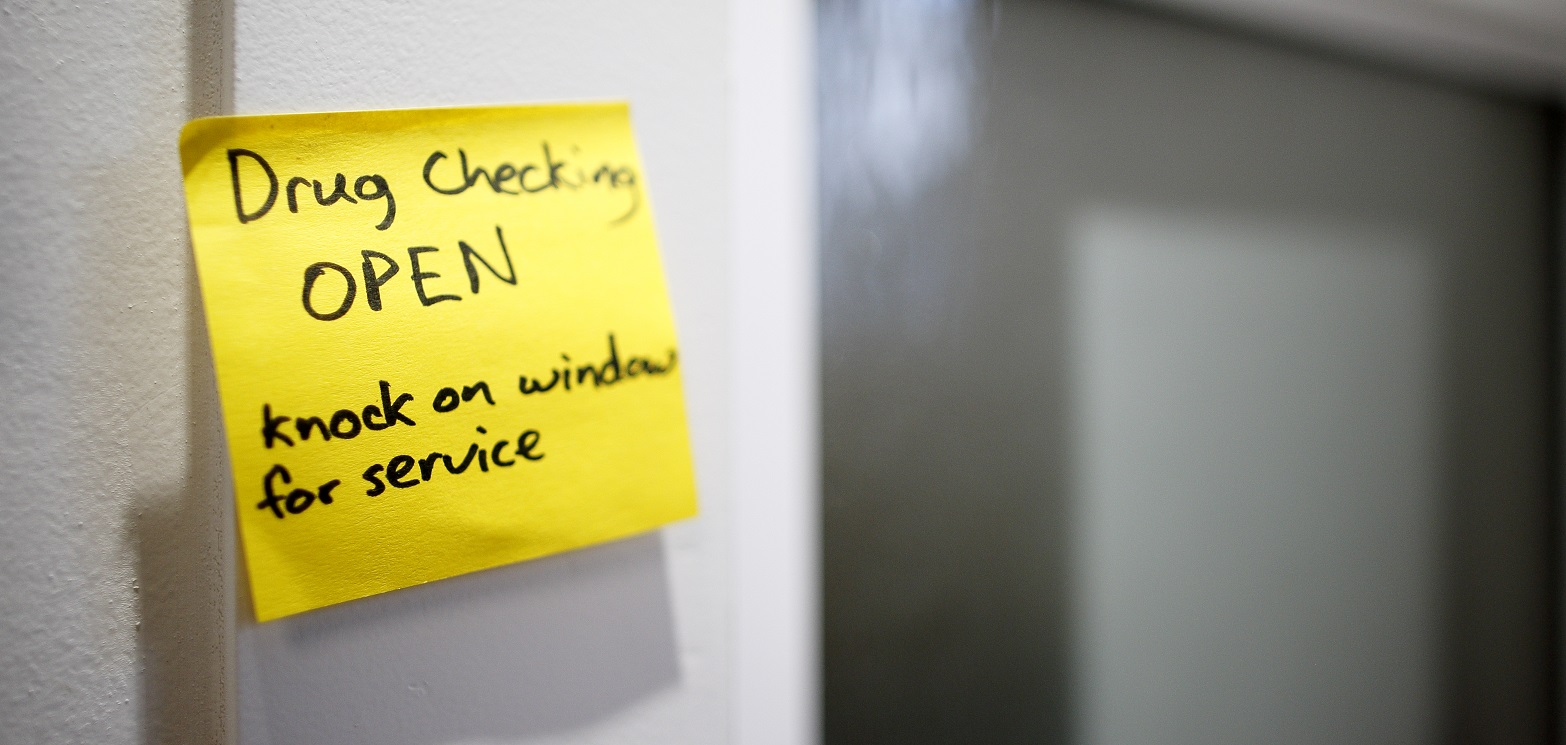
In 2019, Lantern Services took over the renovated space in the basement of STS Pain Pharmacy and began accepting drug checking samples through this window.
Drug Checking in Victoria, BC
Concurrently, in early 2019 it was announced that the University of Victoria would be receiving a substantial Substance Use and Addiction Program grant to study the effectiveness of drug checking as a novel service, as well as evaluating how various technologies performed.3 This became the Vancouver Island Drug Checking Project.
The Project is a service-based research project seeking to study drug checking and evaluate the performance of various technologies. It is led by two co-investigators, Dr. Dennis Hore (Chemistry) and Dr. Bruce Wallace (Social Work). Lantern Services has been a site with the Project since the beginning, and it has been a pleasure to be a part of such a multidisciplinary team involving students and staff from various backgrounds and areas of study.
The red tape involved with carrying out research in the area of illicit substances is substantial. A federal exemption like the one Lantern Services possess makes it easier to get further exemptions to acquire pharmaceutical standards to create mixtures to be systematically studied by various instruments. Lantern Services has enabled research in this area, leading to multiple publications4,5,6,7,8,9. While Lantern is primarily used for research purposes these days, public drug checking services are offered at the Drug Checking Project’s new location: Substance.
Substance is on a busy intersection in the city there is a lot of foot traffic, with people stopping in to ask questions, or to receive naloxone training. A visible site like Substance acts to break down stigma and facilitate conversation and dialogue within the community. In August, 245 service users checked 229 samples; in September, 160 service users checked 262. This highlights the popularity of this emerging service.
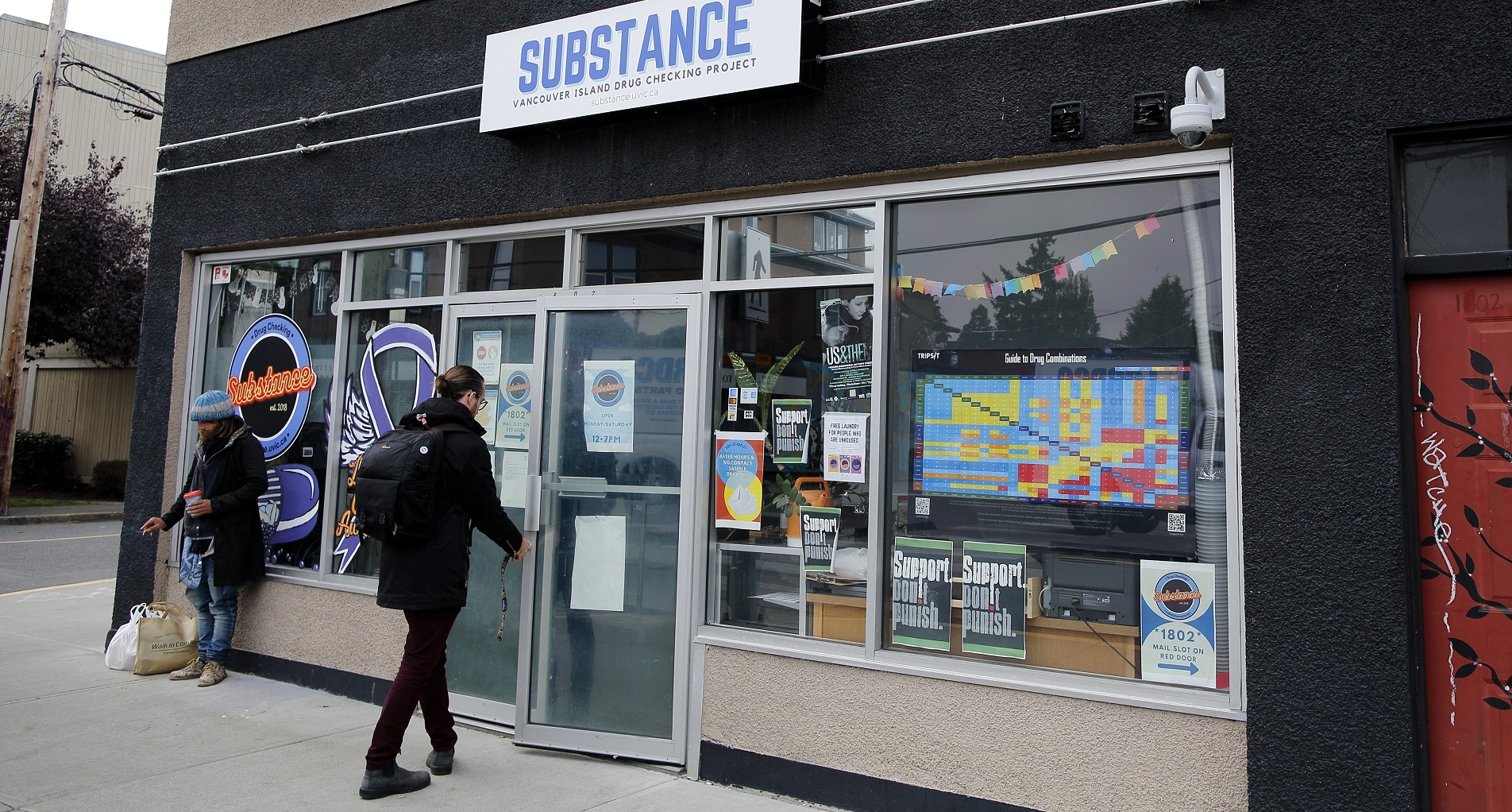
While Lantern is primarily used for research purposes these days, public drug checking services are offered at the Drug Checking Project’s new location: Substance, located at 1802 Cook Street.
An important function of drug checking is identifying when there is a baggie mixup. An example is when a service user checks what they thought was a non-opioid sample (i.e. ketamine, MDMA or cocaine) when it was in fact down. This means a potentially opioid naive substance user was about to consume an appreciable amount of fentanyl, and would have led to a potentially fatal overdose.
Another important detail is gauging the potency of fentanyl. The fentanyl strip tests give a binary result — a “yes” or “no” indicator of whether fentanyl is present in a sample. This information is very impactful in a non-opioid sample, however when testing down, a positive fentanyl strip test does not mean much. The more important question is how much fentanyl is present? This question is now being answered, thanks to an ongoing collaboration with Dr. Chris Gill and his team at Vancouver Island University. As of October, the paper spray mass spectrometer is now housed at Substance. This instrument can provide point of care quantitative results to service users, and the aggregated results are informing the prescribing patterns of the addiction medicine community in Victoria.
Please visit substance.uvic.ca to learn more about the Vancouver Island Drug Checking Project, including access to monthly reports and to subscribe to the mailing list, In the blog section there is a review on Victoria’s drug supply10 which goes into detail about the project, technologies and current findings.
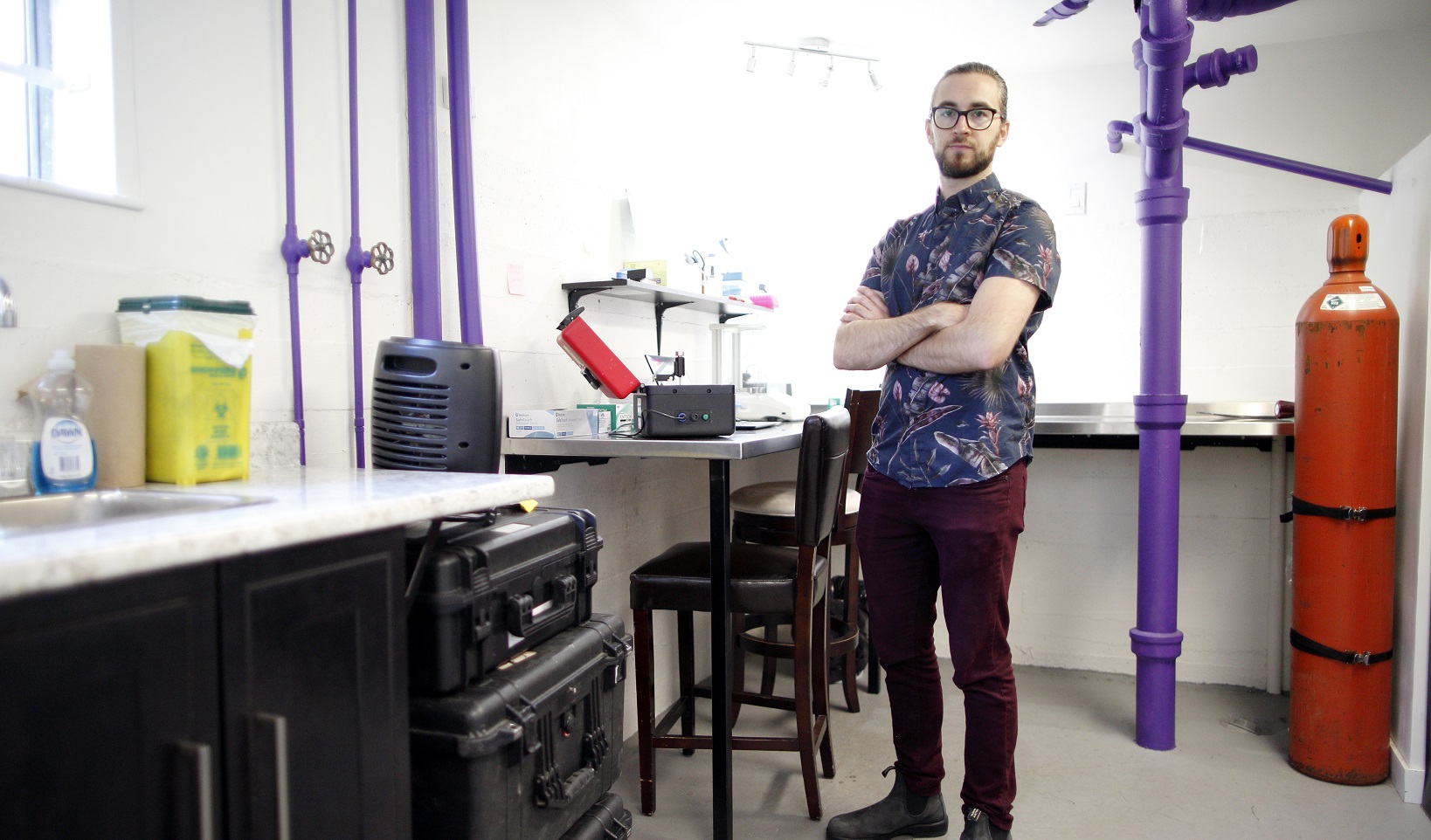
Jarred Aasen and his drug checking equipment at Lantern Services. As a community pharmacist, Aasen believes pharmacists are well positioned to play a role within drug checking, but this requires regulatory permission and incentives for pharmacists to perform the service.
Role of Pharmacists
PWUD are in our communities and are deserving of interventions to help reduce their risks. Drug checking, alongside other harm reduction interventions, is a life saving service that is ready to implement today. One challenge of providing this service is receiving the proper exemption or designation to allow for such work. In late October, the province of British Columbia approved regulatory pathways for a distributed model of drug checking, which allows for the collection, storage and transport of small samples of illicit drugs for the purposes of drug checking or laboratory analysis.
Pharmacists are well positioned to play a role within drug checking. We are trained to handle sensitive information, to disclose results and, as a profession, provide capacity for rural reach. Using the discrete symbol of the purple lantern, participating pharmacies could collect samples, help fill out an accompanying survey and ensure the sample is couriered off to a central laboratory for testing. The results could then be accessed by the service user remotely, or disclosed by the pharmacist. Pharmacists could opt in for a training module specific to drug checking considerations.
The toxic drug supply crisis is not new, and the numbers are not slowing down. Expanding the scope of practice of pharmacists to include drug checking would require advocacy from the College of Pharmacists of British Columbia, including allowances for billing of services. This would require the Ministry of Health to determine a fee for service structure that incentivizes pharmacies to take up drug checking. My experience has taught me the importance of drug checking and the utility it can provide for my patients and the community at large. For this reason, I urge pharmacists to consider this critical service.
Lantern Services
The idea of Lantern Services is not a proprietary concept. It represents the idea that knowledge can and must be shed in this area, as stigmatization and misinformation can be curbed. As per the website: “Lantern Services aims to be a safe, comfortable place where people can have open non-judgmental conversations about substance use. Our hope is to reduce the stigma involved with substance use, allowing people to ask questions and receive help if needed. This initiative will give individuals the information they need to make informed decisions regarding their health.” This goal is not unique to Lantern Services, rather it is an informal mission of many drug-checking services.
Results of individual drug checks should be delivered in a manner that is objective and neither condones nor condemns substance use. This environment can lead to a fruitful exchange of information — between both service users and service providers — or to important referrals to others services. The goal of drug checking is to have the service user leave feeling more empowered in their decisions.

The Lantern represents the idea that knowledge can and must be shed in this area, as stigmatization and misinformation can be curbed.
References
- Illicit Drug Toxicity Deaths in BC: January 1, 2011 – June 30, 2021. BC Coroner’s Office. Aug 2021.
- Victoria pharmacy finds fentanyl in 90% of street drugs tested. CBC News. Mar 2017.
- UVic partners with harm reduction groups to run a drug checking pilot project. Vic News. Apr 2019.
- B. Wallace, T. van Roode, F. Pagan, P. Phillips, H. Wagner, S. Calder, J. Aasen, B. Pauly, D. Hore. "What is needed for implementing drug checking services in the context of the overdose crisis? A qualitative study to explore perspectives of potential service users" Harm Reduct. J., 17, 29 (2020)
- B. Wallace, R. Hills, J. Rothwell, D. Kumar, I. Garber, T. van Roode, A. Larnder, F. Pagan, J. Aasen, J. Weatherston, L. Gozdzialski, M. Ramsay, P. Burek, M. Azam, B. Pauly, M. Storey, D. Hore. "Design and Implementation of a Multi-Technology Platform for Drug Checking: Social, Scientific, and Technological Considerations" Drug. Test. Anal., 13, 734 (2021)
- L. Gozdzialski, M. Ramsay, A. Larnder, B. Wallace, D. Hore. "Fentanyl Detection and Quantification using Portable Raman Spectroscopy in Community Drug Checking" J. Raman. Spectrosc., 52, 1308 (2021)
- M. Ramsay, L. Gozdzialski, A. Larnder, B. Wallace, D. Hore. "Fentanyl Quanitification using Portable Infrared Absorption Spectroscopy. A Framework for Community Drug Checking" Vib. Spectrosc., 114, 103243 (2021)
- L. Gozdzialski, J. Aasen, A. Larnder, M. Ramsay, S. Borden, A. Saatchi, C. Gill, B. Wallace, D. Hore. "Portable Gas Chromatography-Mass Spectrometry in Drug Checking: Detection of Carfentanil and Etizolam in Expected Opioid Samples" Int. J. Drug Policy, 97, 103409 (2021)
- A. Larnder, P. Burek, B. Wallace, D. Hore. “Third party drug checking: accessing harm reduction services on the behalf of others” Harm Reduct. J., 18, 99 (2021)
- A Review on Victoria's Drug Supply. Vancouver Island Drug Checking Project Blog. Jul 2021.
For advertising inquiries, please contact angie.gaddy@bcpharmacy.ca

